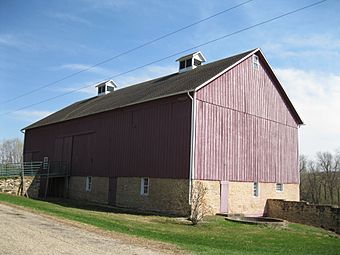Bedrud-Olson Farmstead facts for kids
Quick facts for kids |
|
|
Bedrud–Olson Farmstead
|
|

Barn on the farmstead.
|
|
| Location | 996 E. Church Rd., Christiana, Dane County, Wisconsin |
|---|---|
| Area | 3 acres (1.2 ha) |
| Built | 1856 |
| Architectural style | Italianate |
| NRHP reference No. | 99000429 |
| Added to NRHP | April 1, 1999 |
The Bedrud–Olson Farmstead is a very old farm in Christiana, Dane County, Wisconsin. It has many buildings that were built between 1856 and 1915. This farm was important for growing tobacco and raising dairy cows. Because it's so well-preserved, it was added to the State and the National Register of Historic Places in 1999.
Contents
Who Started the Farm?
From Norway to Wisconsin
In 1844, a couple named Tosten Lieberson Bedrud and Christie Gunderson Vossolt came to America from Norway. They decided to settle and start a farm in Wisconsin. Their farm was in the middle of a small Norwegian farming area, west of Lake Koshkonong.
When they first arrived, Tosten and Christie built a simple dugout house. This was near where the main house stands today. At first, they only grew enough food to feed themselves and their family.
Growing the Farm and Family
By 1856, Tosten and Christie had seven children. They also started growing wheat to sell. That same year, they replaced their dugout home with a wooden house. Part of this wooden house is still part of the main house today. Tosten passed away in 1857.
Later, in 1874, their son Hellick Tostenson bought the farm. By 1877, the farm had grown to 198 acres.
The Farm's Big Changes
Shifting to Dairy Farming
Around the time of the American Civil War, the farm started to change. Instead of mostly growing wheat, they began to focus on dairy farming. This meant they had more cows.
In 1883, Hellick built the large barn you can still see today. It had a strong limestone wall at the bottom. The upper walls were made of cedar wood in a style called board and batten.
Modern Barn Features
This barn was very modern for its time! It had two tall, round structures inside called silos. Silos are used to store food for cows during winter. The University of Wisconsin–Madison had just started telling farmers to use silos, so Hellick was ahead of his time.
The barn also had special areas for baby calves. It even had a water system that used gravity to bring water to the animals. There was also a system to remove animal waste and special vents for fresh air. These features were used until the 1960s and are still mostly the same!
Expanding the House
Also in 1883, Hellick added another part to the house. This was to make space for another family. They needed more people to help work on the growing farm.
Tobacco Farming Begins
New Owners and New Crops
In 1889, Hellick's sister Anna and her husband Anton Olson bought the farm. Anton was also an immigrant from Norway. By this time, growing tobacco was becoming a big part of the farm's business. They had about 15 acres of tobacco plants. This was a special kind of tobacco used for cigar wrappers, which was common in Dane County.
Special Tobacco Sheds
In 1890, Anton and Anna built a special shed near the fields. This was a tobacco-curing shed. In this shed, every third board on the side could open like a hinge. This allowed the farmers to control how much air reached the tobacco leaves as they dried inside.
Two other old curing sheds were moved to the farm in 1906 and 1908. In 1910, a "stripping shed" was built. Here, workers would take the dried leaves off the tobacco stalks. Then, they would pack the leaves into crates to sell.
The Farm's Later Years
Keeping Things the Same
Henry and Martin Olson, who were Anton and Anna's sons, bought the farm in 1918. They continued to farm there until the 1970s. These brothers didn't change the farm much over the years.
Today, there are other farms in the area that also grew both dairy and tobacco. But the Bedrud–Olson Farmstead is special. It still has almost all of its original buildings from the late 1800s and early 1900s. No new buildings were added, which makes it a great example of an old farm.

